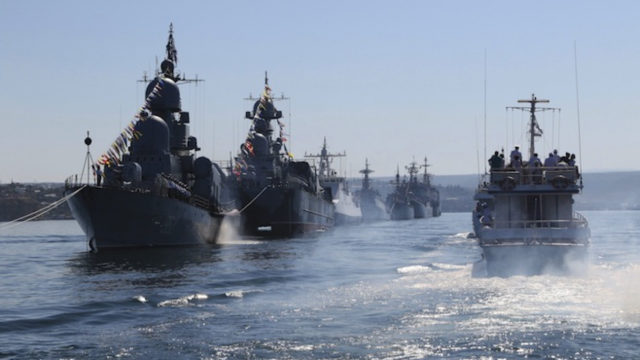
Russia’s Unilateral Black Sea Aggression Elicits Protests From Ukraine, Georgia
Publication: Eurasia Daily Monitor Volume: 17 Issue: 14
By:

Since the 1991 implosion of the Soviet Union, the Russian Federation’s relations with its immediate Black Sea neighbors—the former Soviet republics of Georgia and Ukraine—have veered from frigid to open conflict. Russia engaged in a brief war in 2008 with Georgia; then, six years later, it forcibly absorbed Ukraine’s Crimea and sparked a “separatist” war in Donbas. Now, the latest flashpoint between the trio has been over the Sea of Azov and the northeastern Black Sea. On January 18, 2020, Ukraine and Georgia filed a complaint with the International Maritime Organization (IMO) over Russia’s unilateral and unlawful actions obstructing search-and-rescue operations in the Black Sea, the Sea of Azov and the Kerch Strait, which connects the two larger bodies of water (RIA Novosti, January 18). The same day the complaint was filed, the first deputy head of the Russian Federation Council’s (upper chamber of parliament) international committee, Federal Security Service (FSB) General Vladimir Dzhabarov, labeled it a “provocation” (RIA Novosti, January 18). The incident is the latest in a series of maritime disputes between Russia and Ukraine over the legal status of the Black and Azov seas (see EDM, January 23).
Since the beginning of the year, the diplomatic stalemate has resulted in increased saber rattling by both Ukraine and Russia. On January 4, Black Sea Fleet service members in Russia’s Crimean and Novorossiysk naval bases held an exercise aimed at countering underwater saboteurs (New-sebastopol.com, January 4). Five days later, ships from Russia’s Black Sea and Northern fleets held a joint exercise off the Crimean coast. President Vladimir Putin observed the deployment from aboard the Northern Fleet’s Marshal Ustinov guided-missile cruiser, which had been earlier dispatched to the eastern Mediterranean to assist Syria before transiting the Turkish-controlled Dardanelles and Bosporus (often jointly referred to as the Turkish Straits). Fifty ships, a submarine and more than 40 aircraft participated in the exercise, which featured Kalibr cruise missile launches and test-firing the hypersonic air-launched Kinzhal missile (New-sebastopol.com, January 9).
On January 18, the same day Kyiv and Tbilisi filed their IMO complaint, Ukraine’s Joint Forces Operation (JFO) headquarters was forced to deny Ukrainian media reports that it had been mining an area along the country’s Azov coast. Posting on its Facebook page, the JFO headquarters noted, “Some Ukrainian media reported on the start of the active phase of the installation of minefields along a probable landing area on the coast of the Sea of Azov. Measures of combat training for the boat-and-cutter unit of the Triton tactical group are of only educational and training nature and do not involve any actions involving the actual mining of a Sea of Azov area” (Ukrainskaya Pravda, January 18).
To address their regional insecurities, Ukraine and Georgia can theoretically seek Partnership for Peace (PfP) program support from the three North Atlantic Treaty Organization (NATO) members located along the Black Sea basin: Turkey, Bulgaria and Romania. However, any maritime assistance from non–Black Sea NATO members is severely constrained by the 1936 Montreux Convention, which heavily limits the type, tonnage and duration of extra-regional maritime forces that can be introduced to the Black Sea via the Turkish Straits (Treaties.un.org, July 20, 1936, accessed February 1, 2020).
In the future, Russia’s maritime Black Sea dominance is likely to increase given the Ministry of Defense’s projected acquisition plans. In 2019, the Ministry signed nearly 50 contracts with Russian defense companies for a record-high total of more than one trillion rubles (over $16 billion) (RIA Novosti, January 2, 2020). This amount includes planned purchases of two Russian vessels similar to the French-built Mistral-class helicopter-carrying amphibious assault ships, reportedly to be laid down in Kerch in 2020.
The Russian navy’s long-running interest in amphibious assault ships underlay its annulled purchase of two French-built Mistrals initiated in 2009, which, had it been successful, would have represented Russia’s largest acquisition of foreign warships since the World War II Lend-Lease program. That the acquisition would have radically changed the maritime balance in the Black Sea was underlined by the then-head of the Russian navy, Admiral Vladimir Vysotsky. In referring to Russia’s brief conflict with Georgia in August 2008, he stated that possession of “a ship like that [the Mistral] would have allowed the Black Sea Fleet to accomplish its missions in 40 minutes, not 26 hours, which was how long it took us” (Apsny.ge, September 15, 2009). The laying down of the two keels in Kerch is proof that the Russian navy’s interest in such ships continues.
Russian-Ukrainian maritime disputes involving the Black and Azov seas seem likely to remain stalemated for the foreseeable future, if for no other reason than that the maritime forces of Ukraine and Georgia remain modest compared to those of Russia’s Black Sea Fleet. Moreover, Russia can quickly reinforce the Black Sea Fleet by bringing in Caspian Flotilla warships via its internal Volga–Don Canal, as well as introduce further naval units from its Baltic, Northern and Pacific fleets into the Black Sea basin under its Montreux Convention privileges. Despite the diplomatic objections Kyiv and Tbilisi have raised over Moscow’s unilateral maritime actions in this region, the absence of a united transatlantic front may enable this to become another case of “might makes right.”



